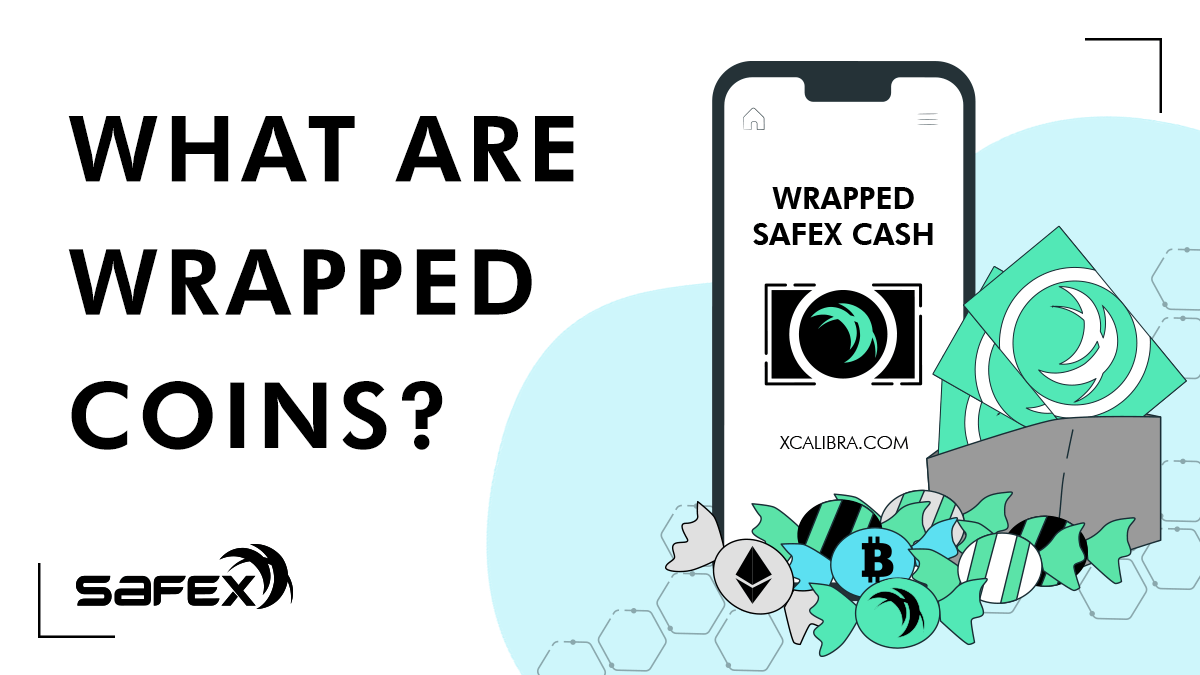What Are Wrapped Coins?
Read the basic explanation of what Wrapped Coins are.

So we have coins on their native blockchains (eg. Bitcoin, Ethereum, Monero, Safex Cash and Tokens) and we have other crypto coins that were created as tokens, piggy-backing on another blockchain, such as all projects that launched as ERC20 tokens on Ethereum. Many of those ERC20 tokens were only placeholder tokens, to be swapped when the project launched their own blockchain ecosystem, while others were only ever intended to exist as an ERC20 token.
But what is a wrapped coin?
А wrapped coin is a crypto coin that is connected to the value of another coin, but exists on a different blockchain. Usually, one coin gets wrapped by creating a version of it on another blockchain and as a result of arbitrage trading the wrapped coin’s value tends to be aligned to the price of the original coin. When a wrapped coin gets minted, the original coin gets locked away. When the wrapped coin gets burned, the original coin is released back into circulation on the native blockchain.
Some of the first wrapped coins that were made include: wrapped Bitcoin, wrapped Ethereum, and many others. Usually, coins get wrapped in Ethereum, Tron, and/or Binance blockchains.
The wrapped coin is a placeholder token for the original coin, but now on a different blockchain, which should mean they are equally valued, as they can be exchanged (minted or burned) 1:1 at any time on the exchanges. However, due to differences in supply and demand of each coin on their own network, some price variance can exist between the original coin and it’s wrapped counterpart. An example is the native Safex Cash (SFX) and the BEP20 Wrapped Safex Cash (WSFX), which exists on the Binance blockchain. The minting/burning process is done via a Binance Chain smart contract.
Why would some dev team make wrapped coin?
All the blockchains work alone, not related to others. With wrapped coin technology, a coin can exist as the original version on its native blockchain, or alternatively, in the wrapped version on some other blockchain. The supply of wrapped coins is limited to the number of native coins that have been deposited for wrapping, and obviously can never exceed the original coins max supply. The wrapping of the original coins requires some form of custodianship of those original coins for which wrapped equivalents have been minted.
Most crypto coins get wrapped onto a blockchain that has either a smaller fee or on a blockchain with faster transaction times. In the case of Safex Cash, it was wrapped to provide wider and faster exposure on other popular trading platforms, which will make it easier for people to then access native Safex Cash, to buy goods and services on the Safex Marketplace.
How do wrapped tokens work?
Usually, there are three entities in the process of getting wrapped coins: User, Merchant, and Custodian. The User is any customer who wants to purchase a wrapped coin. The Merchant, in most instances, is an exchange that supports such coins. The Custodian keeps coins in the treasury and takes an active role in the wrapping process.
There are two different transactions happening:
- minting - creating wrapped coins; and
- burning - destroying wrapped coins.
Minting and burning are visible on the blockchain explorer of the wrapped coin. Depending on the native coin, you may also be able to look at the Treasury address to see the number of locked native coins - these should always match the number of wrapped coins currently minted. For privacy coins like Safex Cash, this process is a little more difficult, as balances aren’t visible via the Safex Block Explorer. This will be further explained in a separate article.
Behind the scenes, it looks like this: The Custodian receives X native coins from a Merchant with a request to minted wrapped coins. The Custodian will mint X wrapped coins in proportion 1:1 via the smart contract, and the X native coins will be locked with the Custodian in the Reserve wallet. The wrapped coins are then returned to the Merchant.
Side note: for some wrapped coins, like wBTC, certain Merchant entities also have the capacity to mint. However, for WSFX, only the Safex Foundation, in its capacity as Custodian, has the mint capacity.
The minting of wrapped coins can be seen on the blockchain explorer, by looking at the contract address. In the case of WSFX, it is Binance explorer.
The opposite transaction is the process of burning. While a user may simply be able to use the services of an Exchange to swap their wrapped coins for native coins, the exchange may end up in a position where it holds too many wrapped coins and insufficient native coins to perform further swaps. They need to burn some of their wrapped coin holdings back to the naticve coin.
To do this, the opposite transaction will be conducted. In that process, The Merchant sends Y wrapped coins to the Custodian with a request for burning. The Custodian then uses the smart contract to trigger a burn of those Y wrapped coins, which get destroyed, and the corresponding Y native coins are released by the Custodian from the Reserve wallet, and get sent back to the Merchant who requested the burn.
This means there is always an accurate amount of native + wrapped coins in circulation, and the amount of max supply of the native coin will stay unchanged.
So how does a person access the wrapped coin?
For a user looking to acquire a wrapped coin, they will use a platform that has the wrapped coin listed. For BEP20 coins, PancakeSwap (Trust Wallet v2) is one such example. The user will send some amount of token (BNB) on the swap exchange and buy the wrapped coin. They will immediately get their wrapped coin in their wallet address.
Alternatively, holders of the native coin can use an exchange or other service provider that allows trading to the wrapped coin. They can then trade the native coins they hold into the wrapped versions. Why would they do this? They may want to act as a Liquidity Provider (LP) for the platform upon which the wrapped coin is being traded, or they may want to sell some of their bag, and the wrapped version gives them access to wider selection of other coins they may be wanting to acquire.
Read more about Wrapped Safex Cash and how to swap BNB for WSFX.
